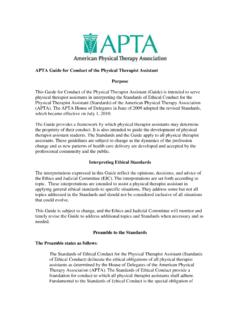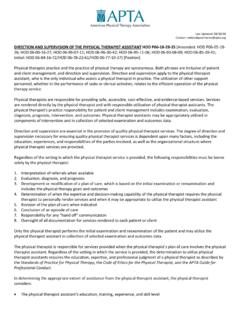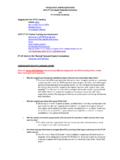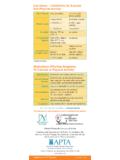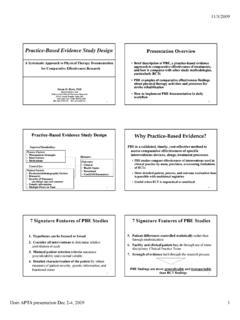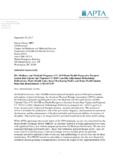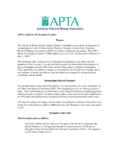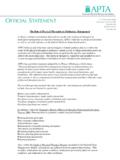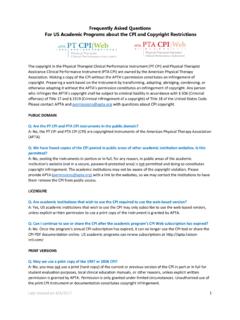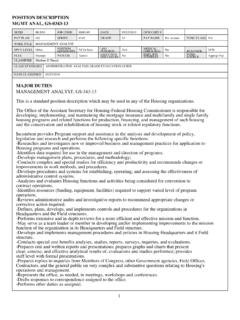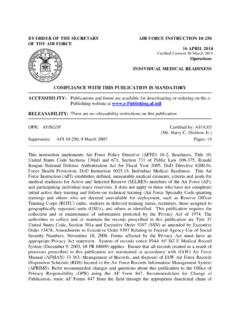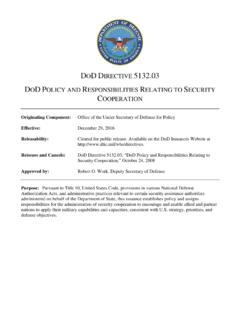Transcription of optimize the patient’s participation in achieving …
1 January 6, 2015 Marilyn Tavenner Administrator Centers for Medicare & Medicaid Services Department of Health and Human Services Room 445 G Attention: CMS-3819-P Hubert H. Humphrey Building, 200 Independence Avenue SW Washington, DC 20201 Submitted Electronically RE: CMS-3819-P; Medicare and Medicaid Programs; Conditions of participation for Home Health Agencies Dear Administrator Tavenner: On behalf of our 90,000 physical therapist, physical therapist assistant, and students of physical therapy members, the American Physical Therapy Association (APTA) appreciates the opportunity to submit the following comments in response to the Conditions of participation for Home Health Agencies proposed rule.
2 Physical therapy is a qualifying service under the Medicare home health benefit and comprises a large portion of the treatment furnished to patients in the home health setting. Therefore, our members and the patients they treat are impacted significantly by the proposed rulemaking and subsequent implementation. In the home health setting, physical therapists provide services to patients through a plan of care to engage and optimize the patient s participation in achieving shared goals of improved functional performance, reduced risk of injurious falls, and reduced risk of acute hospitalization thereby promoting long-term health and wellness.
3 Physical therapists provide an examination that includes the history, systems review, and tests and measures to determine the patient s therapeutic, rehabilitative, and functional status and any environmental factors that influence the patient s activity and/or participation . Through the evaluative process, the physical therapist will develop a comprehensive plan of care to achieve the goals and outcomes of improved function. 2 In the proposed rule, the Center for Medicare and Medicaid Services (CMS) has identified four principles to guide development of the proposed new home health agency (HHA) COPs.
4 They are to: Develop a more continuous, integrated care process across all aspects of home health services, based on a patient-centered assessment, care planning, service delivery, and quality assessment and performance improvement. Use a patient-centered, interdisciplinary approach that recognizes the contributions of various skilled professionals and their interactions with each other to meet the patient's needs. Stress quality improvements by incorporating an outcome-oriented, data-driven quality assessment and performance improvement program specific to each HHA. Eliminate the focus on administrative process requirements that lack adequate consensus or evidence that they are predictive of either achieving clinically relevant outcomes for patients or preventing harmful outcomes for patients.
5 Safeguard patient rights. APTA agrees with these principles in concept and we look forward to working with the agency to ensure proper implementation. While we believe that the draft rulemaking is a step in the right direction, there are several technical and programmatic revisions that are necessary to ensure that the final draft accurately and fully represents the breadth and depth of care provided to patients by HHAs. Therefore, we respectfully request that the following comments and recommendations be given full consideration. Conditions of participation : Comprehensive assessment of patients Section states in part, (c) Standard: Content of the comprehensive assessment.
6 The comprehensive assessment must accurately reflect the patient's status, and must include, at a minimum, the following information: (1) The patient s current health, psychosocial, functional, and cognitive status; (2) The patient s strengths, goals, and care preferences, including information that may be used to demonstrate the patient's progress toward achievement of the goals identified by the patient and the measurable outcomes identified by the HHA; (3) The patient's continuing need for home care; (4) The patient's medical, nursing, rehabilitative, social, and discharge planning needs; (5) A review of all medications the patient is currently using in order to identify any potential adverse effects and drug reactions, including ineffective drug therapy, significant side effects, significant drug interactions, duplicate drug therapy, and noncompliance with drug therapy.
7 (6) The patient s primary caregiver(s), if any, and other available supports; (7) The patient s representative (if any); (8) Incorporation of the current version of the Outcome and Assessment Information Set (OASIS) items, using the language and groupings of the OASIS items, as specified by the Secretary. The OASIS data items determined by the Secretary must include: clinical record items, demographics and patient history, living arrangements, supportive assistance, sensory status, integumentary status, respiratory status, elimination status, neuro/emotional/behavioral status, activities of daily living, medications, equipment management, emergent care, and data items collected at inpatient facility admission or discharge only.
8 3 We recommend that CMS add an item to the comprehensive assessment that addresses the use of standardized tests and measures by home health clinicians. The inclusion of tests and measures is critical to the practice of physical therapy. The use of standardized tests and measures early in an episode of care establishes the baseline status of the patient, assists in the development of the plan of care, and provides a means to quantify change in the patient s functioning. Outcome measures, along with other standardized tests and measures used throughout the episode of care, as part of periodic reexamination, provide information about whether predicted outcomes are being realized.
9 As the patient reaches the termination of physical therapist services and the end of the episode of care, the physical therapist objectively measures the outcomes of the physical therapist services. Standardized outcome measures provide a common language with which to evaluate the success of physical therapy interventions, thereby providing a basis for comparing outcomes related to different intervention approaches. Measuring outcomes of care within the relevant components of function, including body functions and structures, activity, and participation , among patients/clients with the same diagnosis, is the foundation for determining which intervention approaches comprise best clinical practice.
10 Condition of participation : Care Planning, coordination of services, and quality of care Section states in part, Patients are accepted for treatment on the reasonable expectation that an HHA can meet the patient's medical, nursing, rehabilitative, and social needs in his or her place of residence. [Emphasis added] Each patient must receive an individualized written plan of care, including any revisions or additions. The individualized plan of care must specify the care and services necessary to meet the patient-specific needs as identified in the comprehensive assessment, including identification of the responsible discipline(s), and the measurable outcomes that the HHA anticipates will occur as a result of implementing and coordinating the plan of care.
